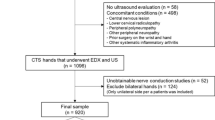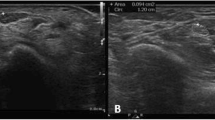Abstract
Background
The aim of this study is to investigate the changes in median nerve and transverse carpal ligament (TCL)-formed carpal arch morphology as possible risk factors for median nerve entrapment in women with type 2 diabetes.
Methods
The distal carpal tunnel was imaged using ultrasound in 30 female subjects (15 with type 2 diabetes, 15 controls). The morphological parameters of the median nerve and carpal arch were derived from the ultrasound images. One-way analysis of variance (ANOVA) was used for statistical analysis.
Results
Diabetic women had an enlarged median nerve area (p < 0.05), salong with a maller carpal arch size, as indicated by a reduced palmar bowing index of the TCL (p < 0.05), and arch area (p < 0.05) than controls. The distance from the median nerve centroid to the volar boundary of the TCL was reduced in diabetic women (p < 0.05) compared to the controls.
Conclusions
Women with type 2 diabetes have reduced available space for the median nerve within the carpal arch due to the enlarged nerve and reduced arch size, making the median nerve more susceptible to entrapment within the tunnel. The current study shows that presence of diabetes increases the risk of median nerve entrapment in women and requires early detection of symptoms to avoid carpal tunnel syndrome.




Similar content being viewed by others
Availability of data and materials
The datasets used and/or analyzed during the current study are available from the corresponding author on reasonable request.
Abbreviations
- BMI:
-
Body mass index
- CTS:
-
Carpal tunnel syndrome
- CSA:
-
Cross-sectional area
- PBI:
-
Palmar bowing index
- TCL:
-
Transverse carpal ligament
- VPT:
-
Vibration perception test
References
Chen SF, Huang CR, Tsai NW, Chang CC, Lu CH, Chuang YC, Chang WN (2012) Ultrasonographic assessment of carpal tunnel syndrome of mild and moderate severity in diabetic patients by using an 8-point measurement of median nerve cross-sectional areas. BMC Med Imaging 12(1):15
Perkins BA, Olaleye D, Bril V (2002) Carpal tunnel syndrome in patients with diabetic polyneuropathy. Diabetes Care 25(3):565–569
Dyck PJ, Kratz KM, Karnes JL, Litchy WJ, Klein R, Pach JM, Wilson DM, O’brien PC, Melton L (1993) The prevalence by staged severity of various types of diabetic neuropathy, retinopathy, and nephropathy in a population-based cohort: the Rochester Diabetic Neuropathy Study. Neurology 43(4):817
Deal C (1998) The endocrine system. Oxford Textbook of Rheumatology, Oxford
Thomsen NO, Mojaddidi M, Malik RA, Dahlin LB (2009) Reduced myelinated nerve fibre and endoneurial capillary densities in the forearm of diabetic and non-diabetic patients with carpal tunnel syndrome. Acta Neuropathol 118(6):785–791
Arumugam T, Razali SN, Vethakkan SR, Rozalli FI, Shahrizaila N (2016) Relationship between ultrasonographic nerve morphology and severity of diabetic sensorimotor polyneuropathy. Eur J Neurol 23(2):354–360
Sassi SA, Giddins G (2016) Gender differences in carpal tunnel relative cross-sectional area: a possible causative factor in idiopathic carpal tunnel syndrome. J Hand Surg (Eur Vol) 41(6):638–642
Lakshminarayanan K, Shah R, Li ZM (2019) Sex-related differences in carpal arch morphology. PLoS ONE 14(5):e0217425
Bower JA, Stanisz GJ, Keir PJ (2006) An MRI evaluation of carpal tunnel dimensions in healthy wrists: implications for carpal tunnel syndrome. Clin Biomech 21(8):816–825
Monagle K, Dai GU, Chu A, Burnham RS, Snyder RE (1999) Quantitative MR imaging of carpal tunnel syndrome. AJR Am J Roentgenol 172(6):1581–1586
Comi G, Lozza L, Galardi G, Ghilardi MF, Medaglini S, Canal N (1985) Presence of carpal tunnel syndrome in diabetics: effect of age, sex, diabetes duration and polyneuropathy. Acta Diabetol Latina 22(3):259–262
Li ZM (2005) Gender difference in carpal tunnel compliance. J Musculoskelet Res 9(03):153–159
Becker J, Nora DB, Gomes I, Stringari FF, Seitensus R, Panosso JS, Ehlers JA (2002) An evaluation of gender, obesity, age and diabetes mellitus as risk factors for carpal tunnel syndrome. Clin Neurophysiol 113(9):1429–1434
Paliwal PR, Therimadasamy AK, Chan YC, Wilder-Smith EP (2014) Does measuring the median nerve at the carpal tunnel outlet improve ultrasound CTS diagnosis? J Neurol Sci 339(1–2):47–51
Dellon AL, Mackinnon SE (1988) Susceptibility of the diabetic nerve to chronic compression. Ann Plast Surg 20(2):117–119
Fitzgibbons PG, Weiss AP (2008) Hand manifestations of diabetes mellitus. J Hand Surg 33(5):771–775
Rosenbloom AL, Silverstein JH (1996) Connective tissue and joint disease in diabetes mellitus. Endocrinol Metab Clin N Am 25(2):473–483
Acknowledgements
The authors thank Dr. Bharani Gopalan at Mother’s Care Diabetes Center for help in recruiting subjects, Karigiri Hospital for providing the hand splint, and Ultraserve Systems for lending the ultrasound machine. Finally, the authors are grateful to all the study participants.
Funding
This research did not receive any specific grant from funding agencies in the public, commercial, or not-for-profit sectors.
Author information
Authors and Affiliations
Contributions
K.L. and R.S. designed the study. K.L. recruited the subjects and conducted preliminary tests for eligibility. K.L. collected data from the subjects. K.L. and R.S. analyzed the data. K.L. wrote the manuscript with R.S. contributing to revisions. K.L. is the guarantor of this work and, as such, had full access to all the data in the study and takes responsibility for the integrity of the data and the accuracy of the data analysis.
Corresponding author
Ethics declarations
Ethics approval and consent to participate
The study protocol was approved by the Vellore Institute of Technology Review Board. Subjects read and signed a written informed consent form approved by the Institutional Review Board before participating in the experiment.
Consent for publication
Not applicable.
Conflict of interest
The authors declare that they have no competing interests.
Additional information
Publisher’s Note
Springer Nature remains neutral with regard to jurisdictional claims in published maps and institutional affiliations.
Rights and permissions
About this article
Cite this article
Lakshminarayanan, K., Shah, R. Median nerve and carpal arch morphology changes in women with type 2 diabetes: a case–control study. J Ultrasound 25, 469–474 (2022). https://doi.org/10.1007/s40477-021-00606-7
Received:
Accepted:
Published:
Issue Date:
DOI: https://doi.org/10.1007/s40477-021-00606-7




